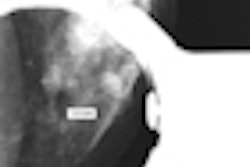The time is now to integrate medical images into electronic health records (EHRs), a PACS implementation expert told attendees last week at the Healthcare Information and Management Systems Society (HIMSS) annual meeting in Atlanta.
Because medical images significantly affect all aspects of patient care, Janice Honeyman-Buck, Ph.D., stressed the importance of imaging informatics being an integral part of any hospital's planned healthcare IT upgrade to receive American Recovery and Reinvestment Act (ARRA) stimulus funds.
There was some irony associated with this message, however: The HIMSS 2010 meeting dedicated only two educational programs out of more than 300 to imaging-related topics, a fact not lost upon the more than 200 commercial exhibitors offering imaging informatics products and services.
Using a fable and the analogy of a line drawn in the sand, over which neither healthcare IT nor radiology PACS professionals crossed, Honeyman-Buck, a consultant with Medical Imaging Consultants of Gainesville, FL, bluntly explained why this situation needs to change.
"Health IT support may not have the skill set to manage images, and radiology support does not have the skill set to manage integration of all hospital information, so we need both groups to work together to create a much stronger system," she said.
The difference in perspectives is considerable. For hospital IT staff, priority is placed on utilizing the HL-7 standard for fast processing of text data rapidly, privately, and securely. For dedicated radiology IT staff, concerns are focused on image acquisition, manipulation, and image storage, as well as the ability to provide rapid access to online and archived images both within an internal network and through Internet access.
This is a major task, she explained, because storing all diagnostic images performed at a 600-bed hospital can easily exceed 25 terabytes a year. Electronic storage, itself, is not the expense it used to be, but managing the storage is expensive. Storage also needs to be secure and redundant, as downtime of a PACS is unacceptable.
What needs to be overcome is territorial turf protection. Everyone wants ownership of the network, according to Honeyman-Buck, who is also a fellow of the Society for Imaging Informatics in Medicine (SIIM), co-sponsor of the session. But healthcare reform demands interoperability of medical records among healthcare providers, and diagnostic imaging is a critical part of the medical record. An EHR must contain images as well as a way to display at least a subset of images identified as key, she explained.
This capability was first proved with the VistA electronic medical record system that manages text, DICOM, and non-DICOM images for all hospitals and outpatient clinics of the Veterans Health Administration. It is becoming commercially available as well. A number of vendors at the HIMSS meeting were demonstrating EMR products and electronic dashboards that merged text and images.
Medical images in a patient's record are not limited to diagnostic radiology and advanced visualization 3D reconstructed images. They also include endoscopy images, cardiology images with huge datasets, dental images, and pathology images, which may contain as much as 40 GB per slide. JPEGs such as dermatology images, documentation of anatomy, and/or a patient ID photo should also be part of an EMR.
Honeyman-Buck recommended that hospital administrators start now to create a bridge between imaging informatics and hospital IT, fostering an environment for these professionals to work together to create a system with meaningful use.
She pointed out that while imaging does not appear to be addressed until 2015 with multimedia support in the national healthcare IT implementation schedule, hospital administrators must realize they need to add imaging and multimedia to the meaningful use scenarios as soon as reasonably possible.
She concluded by referencing an open letter written to Dr. David Blumenthal, national coordinator for health IT of the U.S. Department of Health and Human Services, from Joe Marion, a healthcare industry consultant with more than 30 years of experience in diagnostic imaging communications technology, and a principal with the consulting firm Healthcare Integration Strategies of Waukesha, WI.
"It appears that the healthcare providers I have spoken with are consumed with just addressing their own priorities in order to be positioned to take advantage of ARRA. ... What is being missed is imaging, which has the largest impact on systems capacity with respect to infrastructure and EHRs," Marion wrote in a blog posted August 23, 2009, on the Healthcare Informatics magazine Web site.
"The travesty in waiting to address imaging in terms of a priority will be that whatever early initiatives are put in place may not be capable of supporting imaging when 2015 multimedia support rolls around," he warned. "As one who has lived through inception and implementation of DICOM, letting nature take its course will never enable the objectives of meaningful use to be achieved in the time frame suggested."
By Cynthia E. Keen
AuntMinnie.com staff writer
March 9, 2010
Related Reading
Hospitals need to scramble on stimulus fund goals, March 3, 2010
HIMSS vendors chase 'meaningful use' -- and stimulus dollars, March 2, 2010
Copyright © 2010 AuntMinnie.com



















